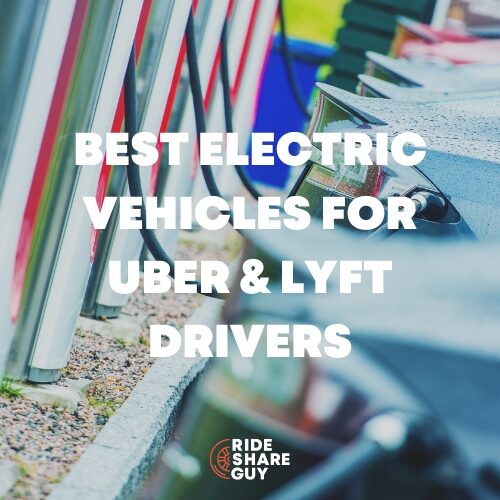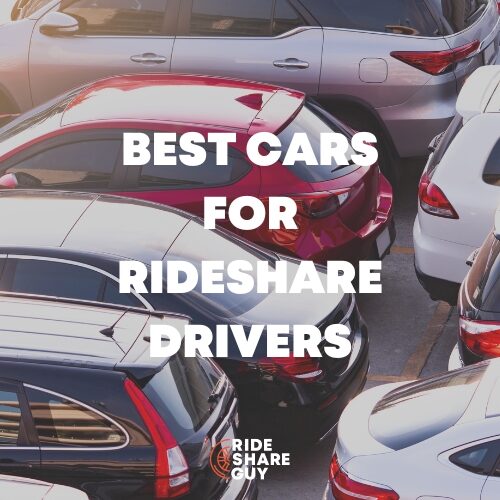Following up on Senior EV Writer Gabe Ets-Hokin’s saga that goes from buying a 2018 Bolt EV, then selling it back to GM, then buying a Tesla Model 3 and then buying another Bolt, we present his full review of using a Bolt EUV for rideshare—the only such review we know of.
EV’s are elitist! After all, the average EV sold for over $60,000 in 2022! Who has that kind of money? They’re only for wealthy, virtue-signaling weirdos!
Or are they? Don’t forget the average price is just that—the average. Some EVs are $150,000 and some are much, much less. Since a rideshare vehicle has to be cost-effective first, maybe we should look at the lowest-priced long-range EV on the market, the Chevrolet Bolt EV and EUV.
Quick Summary:
- The redesigned Chevrolet Bolt and Bolt EUV are economically priced, functional and practical electric vehicles good for rideshare use.
- They start at around $27,000, with the roomier EUV version starting a bit higher.
- Should you get one? It depends!
- Want to chat about all things EV and rideshare related? Join RSG’s EV gig drivers Facebook group!
What is a Bolt?
The Bolt is what it is today because of a long journey that some may say began in 1990 with the EV-1, GM’s first mass-market EV. It was beloved by its 2,500 or so customers, but GM killed the program and we didn’t see another GM EV until the Chevrolet Volt popped up in 2011. That car was a plug-in hybrid (PHEV), but the battery designs and electronics were key to developing the Bolt, which appeared in 2016 as a 2017 model.
The Bolt, like the brilliant musician Billy Preston, has never gotten the respect it deserves. That “Volt” and “Bolt” sound the same when said out loud has led to endless confusion, and GM’s near refusal to advertise the first-generation Bolt for some reason means “Tesla” is now synonymous with “mass-market EV,” and that’s a shame, because it’s really a great car, even without its loss-leader pricing.
With a 238-mile range and acceptable charge times (for 2016) and an after-incentives price as low as $30,000, the original Bolt should have been an amazing hit, but maybe it was a bit ahead of its time. GM sold about 100,000 of them, but by late 2019 they were getting a bit long in the tooth and dealers and used-car sellers were deeply discounting them—my sister bought a 2017 with under 40,000 miles for just $14,000 in 2019; she has it to this day.
A Burning Issue
For the 2021 model year, GM did a bit of a refresh, with slightly new batteries that allowed a little bit more range and a new driver’s seat to address (very accurate) complaints that the old one was likely designed by Torquemada. “Meh,” said consumers, and while they were “meh”-ing, the media started to notice that Chevy Bolts were bursting into flames while charging. A lot—about 19 of these cars, of all model years, caught fire between 2017 and 2021.
The cause? According to noted industrial consultant Sandy Munro, the machines in LG Chem’s factories in Korea or the US that wind the layers of cathode and anode material (think long, alternating sheets of plastic wrapped around a spindle) were just a tiny bit out of alignment, maybe as little as a hundredth of a millimeter, enough to cause a bit of a fold that could, under just the right, one-in-10-million chance, short out the battery and cause a fire.
Rather than figure out which of the 30-million or so individual cells was bad, GM decided to replace all of them at no charge to the owners. That process is still ongoing, and the new batteries have the same 100,000-mile, eight-year warranty of the originals—starting from the re-installation date. Say what you will about GM, but the company does stand behind this product. Buy with confidence, as I did.
Why did I buy it?
Four years ago, I bought a 2018 Bolt. After over three years of rideshare work, it had 82,000 miles on it when GM told me I couldn’t charge it past 80 percent, discharge it past 70 miles of range remaining, or park within 50 feet of another car or structure. Rather than move to Antarctica, I pushed for a buy-back, and six weeks later I was trading it for a very large check.
I bought a Tesla Model 3, which was great, but earlier this year I realized that even though I had rashed the living poop out of my wheels and driven it 16,000 miles in six months, it had appreciated in value by $10,000. Did I want to keep driving that car and watch $50,000 of equity evaporate with the next recession? No! Sell at the top of the market. But what to replace it with?
Another Bolt, of course! The 2022 model, though it shared most of the underpinnings with the first-generation Bolt, had enough improvements to pique my interest, and almost all the other EVs I had driven, tested or read about that I thought were worth owning cost more than the Model 3…except the Bolt. Easy decision.
What were my options?
The 2023 Bolt ranges from $26,595 to $32,695 (the 2022 was more, and there are still some of these around, but there’s a factory GM rebate that gets applied at the time of sale to bring the price in line with the 2023 MSRP, plus a special Uber driver discount of another $2,000).
At the bottom is your basic Bolt—“1LT” in GM-speak. It’s not that basic, especially for the $27,200 MSRP (plus $995 destination). It has the infotainmment and safety features you’d expect in a late-model car. Pay $29,795 for the 2LT and you get leather (and heated) seats, heated steering wheel and the option to upgrade the sound system and add adaptive cruise control.
For 2022, Chevy added the “EUV” submodel, an electric utility vehicle, if you will. A bit cheesy, if you ask me, but it is six inches longer, which puts three more inches of legroom into the passenger seat—a direct pitch for rideshare drivers? Perhaps, as it doesn’t add to front seat comfort or luggage space.
The EUV can be had in two trims, LT and Premier. The LT is basic but still has some more frills than the basic Bolt 1LT for its $28,690 MSRP . Step up to the Premier and it’s $32,695 but you get a suite of upgrades and the option to get GM Super Cruise, which lets you drive hands-free
“Why no all-wheel drive,” you ask? I know, right? The reason is GM was designing the Equinox EV, which will have AWD and will be about $5,000 more than the Bolt EUV. It’ll also be bigger and have faster charging, but won’t be near the Bolt’s happy price point, either.
Why I got the Premier
With all the options, I knew I wanted the best value… and having a Tesla for seven months spoiled me pretty badly. While I could live without the glass roof (which makes the cabin Arabia-like hot in direct sunlight), I knew I wanted all the bells and whistles, and with the 2022 Uber-driver discount I felt like I could afford them. So I opted for the Premier, since it included everything I wanted if I bought the EUV LT and loaded it with all the options, plus it included adaptive cruise control and gave me the option to order the lighter-colored interior.
I could have also added the “sun and sound” package for $2,495, which gets you a giant sunroof and the Bose upgrade to the sound system (the standard Bolt offers this as a stand-alone upgrade for $595). For another $2,200 there’s Super Cruise, which allows hands-free driving on certain stretches of open road, but my Tesla had a similar option and meh.
After swallowing my pride and agreeing to a $2,250 “market adjustment” my local dealer slapped on the car, I was headed to the Uber driver center in Oakland to get the car inspected and added to my account.
Styling
I did not buy the Bolt for its looks. Where the original 2017 Bolt was stubby, yet sleek and stylish, the Bolt EUV is awkward from most angles—the doors look too big and the car is narrow and high,
The best thing I can say about it is it’s innocuous and easily mistakable for just about any small GM product from the past two decades. I can just hear the conversation with a witness now; “so did you notice the make and model of car?” “I don’t know…it all happened so fast! It was beige, a hatchback I think…it had four wheels…um.” The way I drive, this is a good thing.
Interior
I spent three years of my life in my old Bolt’s interior, which was functional and pleasant enough, but kinda basic, as the kids say. The new Bolt is a big leap in the right direction. There’s plenty of soft-touch, more upscale materials and improved soundproofing, and the seat…oh, the seat!
What an improvement over the seat-shaped object in the first-gen car. It’s supportive, wider and is eight-way electrically adjustable, including a perfectly placed lumbar support; no need for my Amazon-purchased memory foam seat cushion to handle a full 11-hour shift. You won’t regret getting the full heating/ventilating experience, as feeling chilled air rush through your naughty bits is worth the extra few bucks a month.
But the best part of the Bolt EUV’s insides is that extra three inches of legroom. It doesn’t sound like a lot, but it makes the backseat noticeably (39 inches of legroom) more spacious. Coupled with that flat, wide floor with no transmission hump and rear-seat passengers are surprised with how roomy it is. Sadly, that doesn’t get you more trunk space; that’s the same as the smaller model, even with seats folded flat.
Handling/Performance
A rideshare driver’s day is filled with U-turns, three-point turns and narrow driveways. The Bolt’s light steering, responsive transmission and light, nimble character couple with a smooth power curve and gentle brakes to make around-town driving something you just don’t think about much.
Short of one of those tiny novelty EVs from Ali Baba I’m not sure there’s an easier-to-drive option, at least for urban driving. The only flaw is the cheap torsion-bar rear suspension, which can’t react to the potholes and broken pavement that are endemic to the city scape; it’s worst when you’re driving fast, but that’s usually when you’re on the way to pick up the passenger, right? I haven’t heard many passenger complaints about the Bolt’s ride quality.
Get out on the open road and I’d just as soon have my old Tesla back. The Bolt EUV’s cheap-o suspension, short wheelbase, extra weight and tall, boxy profile make it bounce and bob in high-speed turns, and if you’re on a high-speed, but bumpy backroad, you’re not going to embarrass any Porsche 911s. But the 201-horsepower motor (one of very few cars that offer that much power under $30,000) and single-speed transmission offer pretty good acceleration, even if you’re not in sport mode.
Tires and brakes are just okay. The brakes do everything they’re supposed to, and you don’t really use them much anyway, but really hard emergency stops don’t give the kind of power and control I like. The good news here is that you don’t really use the brakes so much, especially with the “one-pedal” drive mode button engaged; the car slows down just right on its own with no braking required, and you can fine tune that with the additional regenerative-braking paddle on the steering wheel smooth slowing and stopping.
The un-sporty eco-friendly tires do get you maximum range and are self-sealing, which can save you from a flat or two, but they easily slip and screech, making you feel like a cab driver in Rome even with mildly aggressive acceleration or cornering. That could elicit a complaint or four from your more snowflakey passengers.
Passenger Experience
From what I’ve gathered after about 500 rides, the main thing passengers take away from riding in my Bolt EUV is… nothing. So few of them have remarked on the car—about one in 30 is my estimate—that I might as well have bought a Chevy Trax.
If they do say something, it’s to express surprise at the roominess of the cabin in what looks like a very small car from the outside. It’s so innocuous and quiet I’ve stopped right next to a passenger and they glance at the car for a minute and then look back at their phone wondering where their car is.
Contrast that to my experience with my Tesla, where I started to get tired of answering all the questions about the damn thing. I’m not tired of the slightly higher tips I got with the Tesla, but we’re talking about the difference between 7.5 percent and six.
I drive about 20 hours a week, so that was an extra dollar or two per day. I also didn’t make much more from Uber Comfort or Comfort Electric, so I don’t miss that either, and trading down put $15,000 into the bank.
Range and Charging
The EPA rates the Bolt EUV at 247 miles of combined range, with an efficiency of 3.44 miles per kWh. That’s for combined city and highway driving, and it’s about 12 percent less then the 3.9 miles/kWh I’ve seen in 4,500 miles of driving my car.
Several caveats: I focus on driving short trips for my earnings strategy, which depends on completing Lyft Challenges and Uber Quests, I drive in a temperate climate that rarely gets below 40 degrees or over 80, and I probably spend less than 20 percent of my time driving at higher speeds.
Still, even at higher speeds, the Bolt is efficient. My old Bolt could drive 220 miles on a single charge at about 70 mph driving up the hot California Central Valley with the A/C set at 70 degrees, and Tom Moloughney at Inside EVs squeezed 231 miles out of the EUV he tested at 70 mph (tip: speed the playback up to 1.25 times when you watch his videos).
Plunk along at slower city speeds and your range will be even better. On those days when I’m driving in the flats of the East Bay, going back and forth from Berkeley to North Oakland and then to West Oakland and maybe the lowlands of East Oakland, where it’s flat and I’m driving from stop sign to stoplight, the car’s efficiency will go well north of four miles/kWh—if this describes where you drive (like many of our Florida drivers on our Facebook EV group) ranges approaching 300 miles.
But that’s not where many drivers spend their days. Hilly terrain just kills range, as you can never recover all the energy it takes to get the 3,590-pound EUV up a hill; driving amongst San Francisco’s magical 49 hills gets my efficiency down to the low threes.
Cold weather can sap 20-40 percent of your range too, and if you try to save money or increase the fun factor by replacing the low-rolling resistance Michelins with something grippier or longer-wearing you’ll lose some range there, too. Extreme scenarios can get the Bolt’s range down as much as 100 miles or even more.
Even if you usually don’t drive more than 247 miles in a shift, conditions may still require a charge, so here’s what you need to know about DC fast-charging a Bolt. It’s slow. Really slow, and the only excuses I can think of for GM to use is that the technology is old (but keeps the car very affordable) and they’re being super careful to keep the Bolt from turning into a Blazer, if you know what I mean.
I have been trying to work that joke into something for a long, long time.
The fast-charging tops out at 55 kW. In terms of time, that translates to well over two hours to charge a completely depleted battery to 100 percent, or over 90 minutes to 80 percent. So a long-distance steed the Bolt is not; but adding 100 or more miles in 30 minutes, while you’re inside Whole Foods munching on a tabbouleh-and-beet salad and reading Yoga News during the mid-day lull is fine.
So functionally, I’d say the Bolt’s capabilities are good for you if you rarely drive more than 300 or 350 miles a day (and of course, have a place to charge at the end of your shift to take advantage of off-peak electricity rates) and can work around the effects of inclement weather. Otherwise, sure, stick to a hybrid or a longer-range, faster charging EV like a Tesla or Kia.
Tech
I remember when my mom got her first Volvo, a green 1974 240 wagon. It had vinyl seats, an AM radio with six giant preset buttons and no air conditioning. My older siblings complained, to which my frugal single mother replied, “we don’t need air conditioning, we’ve got a fan!” demonstrating the black-plastic knob as it blew different velocities of hot air into the cabin. We were sweaty on long road trips across that sweltering Sacramento valley but we had an awesome tag line: “but we’ve got a fan!”
Compared to the gadget-laden Teslas, BMWs and Kias out there, the Bolt is plain, but it still has what you need, even in the base trim. In fact, it sports what the Teslas lack—Apple CarPlay and Android Auto, wired or unwired. It works easily enough, but I now understand why the Kia EV6 didn’t offer it wirelessly.
The Bolt’s wireless hotspot (which is very handy if you like to multi-app with a tablet or second phone) interferes with the wireless CarPlay, causing annoying breaks in the music or your Google map disappearing. To my frustration, having OnStar turn off the WiFi doesn’t help the issue, as it’s always broadcasting back there for whatever nefarious purpose.
If you’re not connecting your phone, the tech is adequate. GM offers its own suite of apps for the Bolt’s slow-to-respond 10.2-inch touchscreen, including Pandora, Alexa, a nav app and more. You can control the climate functions through the screen or with real buttons and there are enough menus and buttons to keep you happy.
For $10 or $20 a month (depending on how tenacious you are dealing with the OnStar voices that speak through the magic button on your ceiling), you can get WiFi connectivity and “connected services” that allows you to operate your door locks, ignition, charging and climate control remotely, but there’s no “phone as a key” that the cool kids have; you still have to carry a big, clunky fob around like grandpa. Still, as my mom would say about her Volvo, “it’s fine.” The Bolt gives you all you need, really.
Summary: Should you get one?
If you’ve suffered though the wall-o-text that is my review, you’re probably already sold on buying one of these or are very geeky about cars, which I can appreciate. Like any car, the Bolt EUV isn’t the best car for all drivers, nor is any EV the right choice for many drivers.
But the Bolt is a good choice for most Uber and Lyft drivers, and when/if the incentives get the price of this down below the price of even a decent used Prius or other hybrid, it’s pretty clear it’s a profound bargain that will have real impact on your earnings you’ll notice right away.
Have a Bolt EV or EUV? Have questions about driving an EV? Want to chime in with your experiences or opinions? Post below or check out RSG’s Uber/Lyft EV Driver’s Group on Facebook.
-Gabe @ RSG





